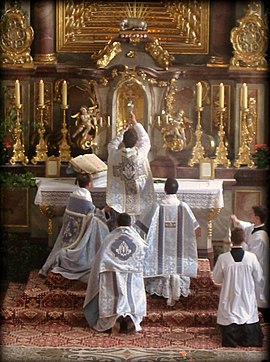
Back Tridentinische Messe ALS Трыдэнцкая Імша Byelorussian Missa tridentina Catalan Tridentská mše Czech Tridentinische Messe German Trenta meso Esperanto Misa tridentina Spanish Tridentiininen messu Finnish Rite tridentin French Aifreann Laidineach Irish

| Part of a series on the |
| Catholic Church |
|---|
 |
| Overview |
|
|
The Tridentine Mass,[1] also known as the Extraordinary Form of the Roman Rite[2] or usus antiquior (more ancient usage), or the Traditional Latin Mass [3][4] or the Traditional Rite[5] is the liturgy in the Roman Missal of the Catholic Church codified in 1570 and published thereafter with amendments up to 1962. Celebrated almost exclusively in Ecclesiastical Latin, it was the most widely used Eucharistic liturgy in the world from its issuance in 1570 until its replacement by the Mass of Paul VI promulgated in 1969 (with the revised Roman Missal appearing in 1970.)[6]
"Tridentine" is derived from the Latin Tridentinus, "related to the city of Tridentum" (modern-day Trent, Italy), where the Council of Trent was held at the height of the Counter-Reformation. In response to a decision of that council,[7] Pope Pius V promulgated the 1570 Roman Missal, making it mandatory throughout the Latin Church, except in places and religious orders with rites or uses from before 1370.[a]
Permissions for celebrating the Tridentine Mass have been adjusted by each modern pope, and most recently restricted by Pope Francis' motu proprio Traditionis Custodes in 2021.[8] This has been controversial among so-called Traditionalist Catholics: some material on the subject may be to some extent partisan.
- ^ "BBC – Religions – Christianity: Tridentine Mass". www.bbc.co.uk.
- ^ "Letter to the Bishops that accompanies the Apostolic Letter "Motu Proprio data" Summorum Pontificum on the Roman liturgy prior to the reform of 1970 (July 7, 2007) | BENEDICT XVI". www.vatican.va.
- ^ "About the Traditional Latin Mass". Traditional Latin Mass Community of Philadelphia. Archived from the original on 2015-09-23. Retrieved 2023-12-22.
- ^ "What's a TLM, anyway? A Latin liturgy lexicon". The Pillar. 9 July 2021. Retrieved 21 July 2021.
- ^ Singh Boparai, Jaspreet (2021-08-26). "Suppression of the Traditional Rite". Catholic Herald. Retrieved 2021-08-26.
- ^ "Library : Liturgical Languages". www.catholicculture.org.
- ^ "CT25". history.hanover.edu.
- ^ Pope Francis (16 July 2021). "Apostolic Letter issued "Motu proprio" by the Supreme Pontiff Francis "Traditionis custodes" on the use of the Roman Liturgy prior to the Reform of 1970, 16 July 2021". vatican.va. Rome. Retrieved 16 July 2021.
Cite error: There are <ref group=lower-alpha> tags or {{efn}} templates on this page, but the references will not show without a {{reflist|group=lower-alpha}} template or {{notelist}} template (see the help page).